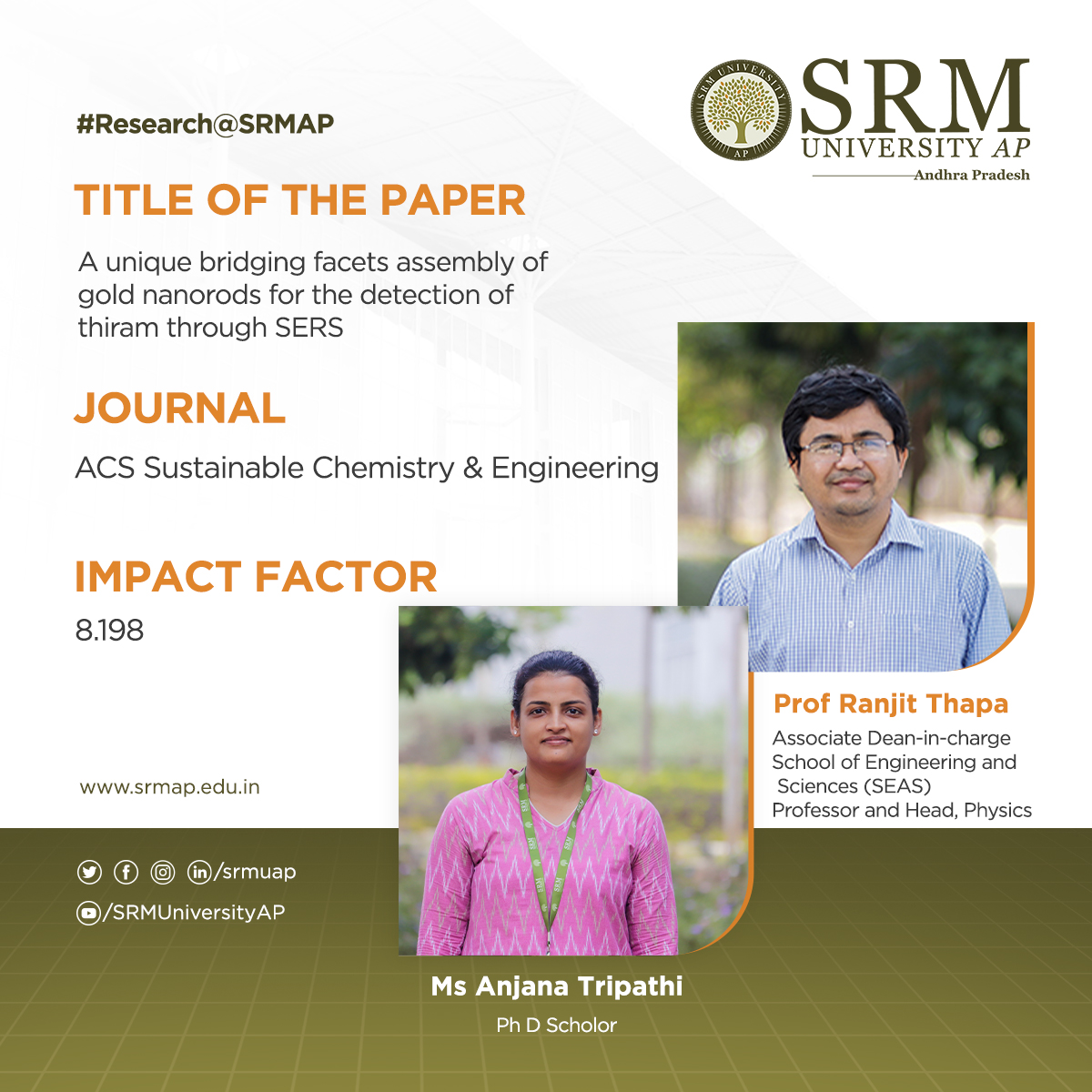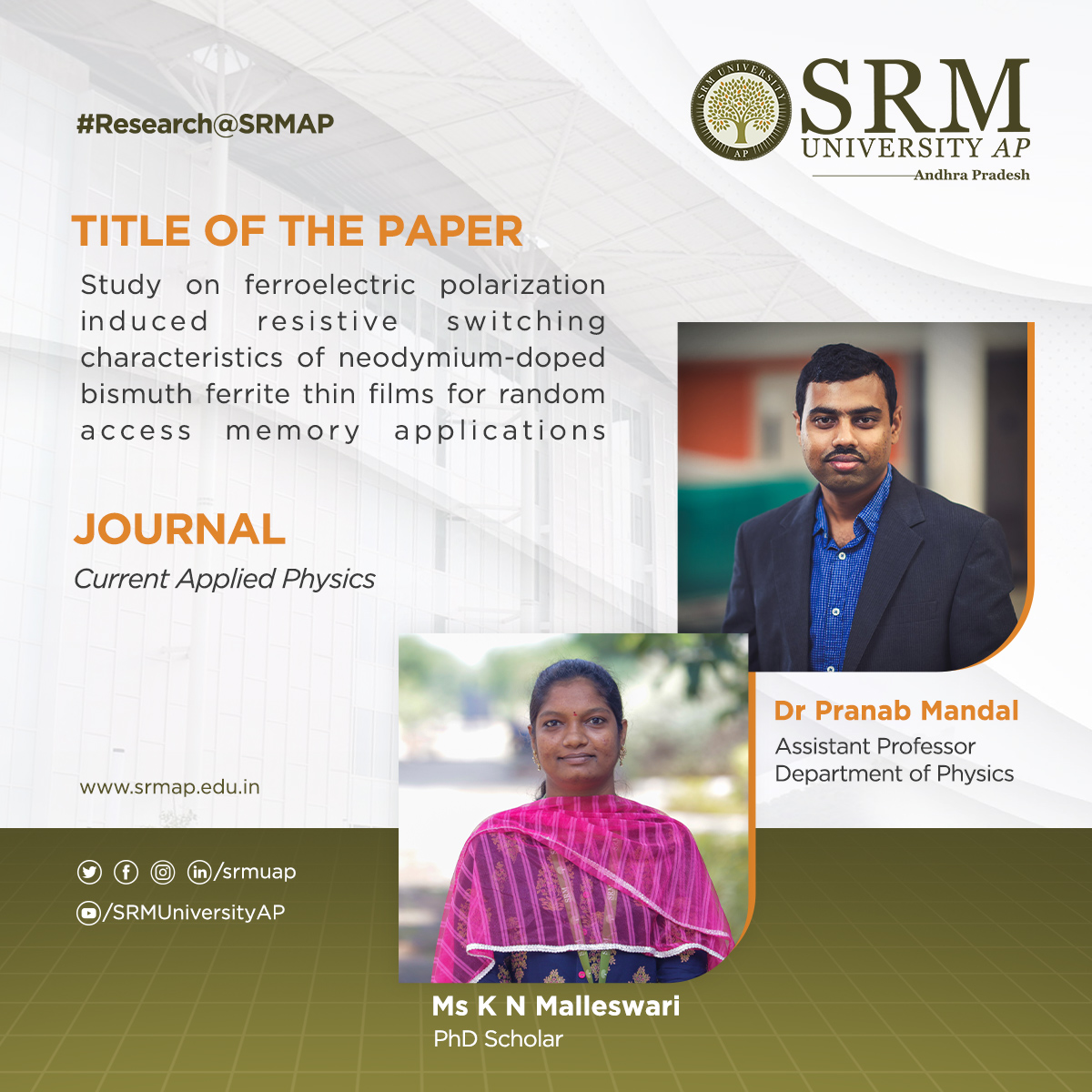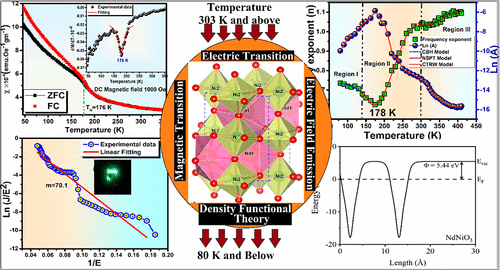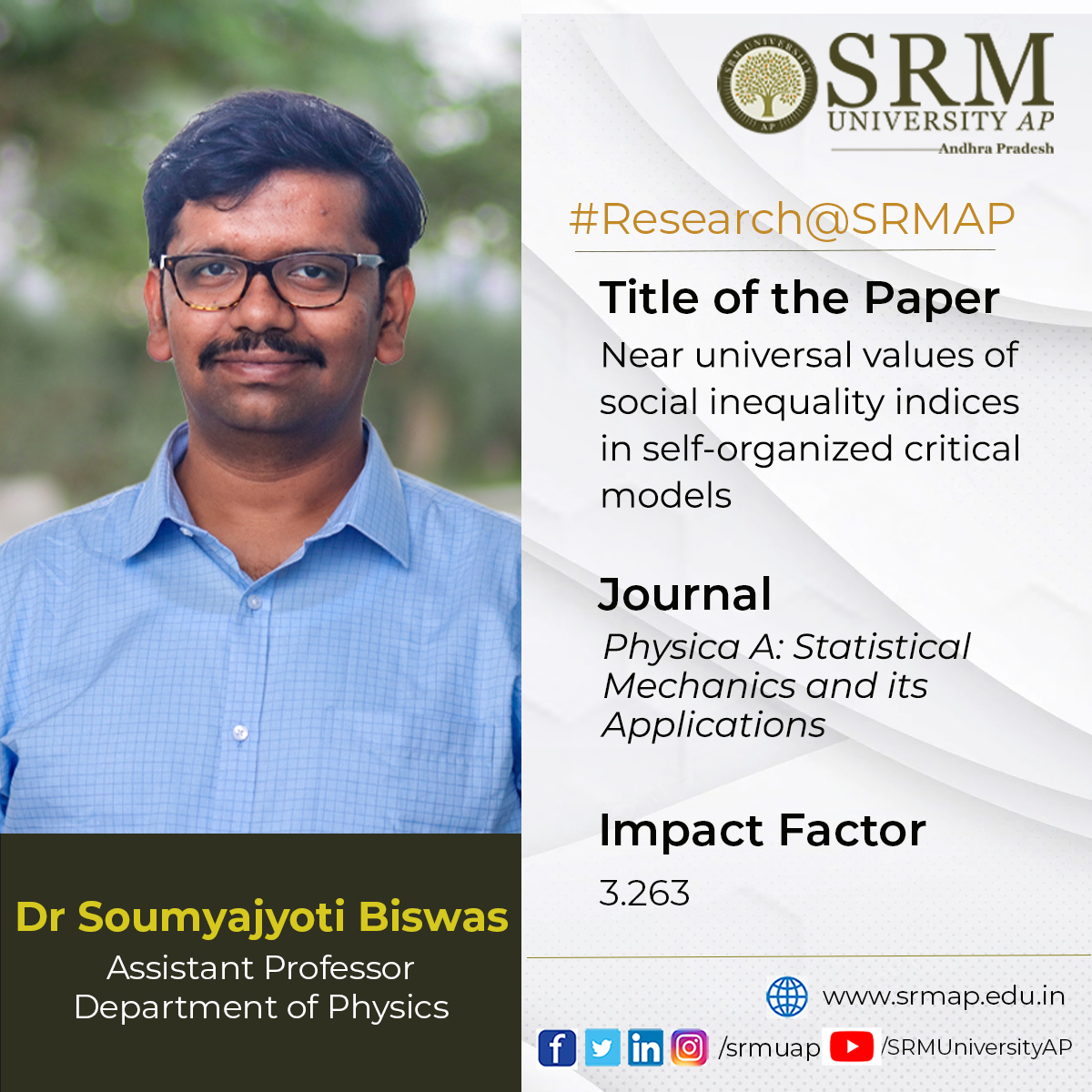Recent News
- A unique bridging facets assembly of gold nanorods June 15, 2022
 The paper “A unique bridging facets assembly of gold nanorods for the detection of thiram through SERS” has been published by Prof Ranjit Thapa, Professor of Physics and his PhD student, Ms Anjana Tripathi, in ACS Sustainable Chemistry & Engineering having an Impact Factor of 8.198.
The paper “A unique bridging facets assembly of gold nanorods for the detection of thiram through SERS” has been published by Prof Ranjit Thapa, Professor of Physics and his PhD student, Ms Anjana Tripathi, in ACS Sustainable Chemistry & Engineering having an Impact Factor of 8.198.Abstract
The addition of Au NRs (Gold Nanorods) to TRM (Thiram) of higher and lower concentrations, yields side-by-side assembly (SSA) and bridging facets assembly (BFA), respectively, and exhibited excellent hotspots for the ultra-low detection of TRM. Bridging facets of Au NRs, such as (5 12 0) and (5 0 12) planes are mainly responsible for the BFA. This kind of interaction is observed for the first time and not reported elsewhere. The detailed facets of Au NRs, namely side facets, bridging facets, and pyramid facets, were discussed with the 3D model of Au NRs. The computational studies confirm the SSA and BFA for Au NRs with varying concentrations of TRM are well in agreement with the experimental results.
Research in brief
Au NRs were synthesized successfully using the seed-mediated method and characterized by UV-Vis analysis, SEM, TEM, FT-IR, Raman, and XPS analysis. Synthesized Au NRs were employed for the detection of TRM. Upon adding Au NRs to TRM of higher and lower concentrations yields side by side (SSA) and bridging facet assembly (BFA), validated by TEM analysis. This unique BFA was observed for the first time and not reported before to the best of our knowledge. Elemental mapping confirms the good adsorption of TRM over Au NRs, and FT-IR, Raman, SERS, and XPS analysis confirm the adsorption of TRM on Au NRs through Au-S bond. A uniformity study was performed for the TRM-Au NRs sample using 25 random places and obtained an RSD of ≤ 10% for each peak in SERS. This shows TRM is uniformly adsorbed on Au NRs. LOD and EF were achieved at 10 pM and 2.8 ×106, respectively. Hence, Au NRs are considered an excellent substrate for the detection of TRM. The unique assembly of BFA may play a significant role in the research community to further study the facet-dependent interactions of nanostructures. The computational study was performed to know the reason behind SSA and BFA. The density functional theory (DFT) was carried out using the Vienna Ab-initio Simulation Package (VASP). The Perdew-Burke-Ernzerhof (PBE) functional within Generalized Gradient Approximation (GGA) is adopted to treat the exchange-correlation interactions. These studies confirm the formation of a strong bond between Au and S, as well as the SSA and BFA for higher and lower TRM concentrations with Au NRs. The binding energy of TRM in SSA and BFA is -3.81 eV and 3.19 eV respectively. From the theory, it shows that TRM of lower concentration form BFA and higher concentration of TRM, due to high barrier energy for TRM diffusion, Au NRs form SSA. In this respect, we calculated the activation barrier for thiram migration from edge site (BFA) to in between site (SSA). Results indicate that TRM needs 2.40 eV energy to migrate from the edge site to in between site to form side-by-side assembly. Therefore, for diffusion from edge to in between (SSA) site high-energy barrier is required i.e. higher concentration is required for such configuration. Hence, at low concentration, TRM will form bridge facet assembly and due to high barrier energy for TRM diffusion, the side-by-side assembly is possible only at high concentration.
Practical implementation/social implications
Concerns have grown in recent years about the widespread use of the pesticide thiram (TRM), which has been linked to negative effects on local ecosystems. This highlights the critical need for quick and accurate point-of-need pesticide analysis tools for real-time applications. The detection of TRM using gold nanorods (Au NRs) with a limit of detection (LOD) of 10-11 M (10 pM) and an enhancement factor (EF) of 2.8 × 106 along with 6.2% of signal homogeneity (with respect to peak at 1378 cm-1) achieved through surface-enhanced Raman scattering (SERS). The interaction of Au NRs with TRM is sensitive, and ultra-low detection of hazardous TRM through SERS makes an ideal technique for environmental protection, real-time applications, and analysis of one-of-a-kind materials.
Collaborations
Bhavya M. B, Akshaya K. Samal
Continue reading →
Institute: Centre for Nano and Material Sciences, Jain University, Jain Global Campus
Ramanagara, Bangalore 562112, India - Enhanced charge transport behaviour of protein-metal nanocluster hybrid June 14, 2022

Proteins are the most vital life forms which maintain close coordination with almost living activities through their biological functions. Nevertheless, in most cases, proteins suffer from low charge (electron) transfer efficiency as they are mainly made of insulating organic molecules. The interdisciplinary research publication, of Dr Sabyasachi Mukhopadhyay and Dr Sabyasachi Chakrabortty from the Department of Physics & Department of Chemistry respectively, along with their PhD scholars: Ms Ashwini Nawade, Mr Kumar Babu Busi and Ms Kunchanapalli Ramya, envisions the molecular-level understanding of the charge transport behaviour of various protein-metal nanocluster hybrid.
The article titled ‘“Improved Charge Transport across Bovine Serum Albumin – Au Nanoclusters’ Hybrid Molecular Junction” was featured in the prestigious Q1 journal ACS Omega (IF: 3.512), published by the ‘American Chemical Society’. They successfully incorporated Gold Nanoclusters inside the protein backbone leading to an increase in their conductivity. This will provide new avenues for the rational design of bioelectronic devices with optimized features. The BSA-Au cluster has been a promising model for bioelectronic functionalities. With an increase in their current carrying capacity, they can be used for many more applications, especially as the interface between tissue and organ in biocompatible devices. The research team is also planning to work with various protein dopants to understand their charge transport mechanism. These studies will help in using the protein for various applications mainly in bioimplants or biosensors for drug testing and diagnostics purposes.
Abstract of the Research
Proteins, a highly complex substance, have been the essential element in the living organism where various applications are envisioned due to their biocompatible nature. Apart from protein’s biological functions, contemporary research mainly focuses on their evolving potential associated with nanoscale electronics. Here, we report one type of chemical doping process in model protein molecules (BSA) to modulate its electrical conductivity by incorporating metal (Gold) nanoclusters on the surface or within it. The as-synthesized Au NCs incorporated inside the BSA (Au 1 to Au 6) were optically well characterized with UV-Vis, time-resolved photoluminescence (TRPL), X-ray photon spectroscopy, and high-resolution transmission electron microscopy techniques. The PL quantum yield for Au 1 is 6.8% whereas Au 6 is 0.03%. In addition, the electrical measurements showed ~10-fold enhancement of conductivity in Au 6 where maximum loading of Au NCs was predicted inside the protein matrix. We observed a dynamic behaviour in the electrical conduction of such protein-nanocluster films, which could have real-time applications in preparing biocompatible electronic devices.
Continue reading → - Neodymium-doped bismuth ferrite thin films for random access memory applications June 13, 2022
 A paper titled “Study on ferroelectric polarization induced resistive switching characteristics of neodymium-doped bismuth ferrite thin films for random access memory applications” has been published by Dr Pranab Mandal, Assistant Professor of Physics and his PhD student, Ms K N Malleswari in the journal ‘Current Applied Physics’ having an Impact Factor of 2.480.
A paper titled “Study on ferroelectric polarization induced resistive switching characteristics of neodymium-doped bismuth ferrite thin films for random access memory applications” has been published by Dr Pranab Mandal, Assistant Professor of Physics and his PhD student, Ms K N Malleswari in the journal ‘Current Applied Physics’ having an Impact Factor of 2.480.Doi: https://doi.org/10.1016/j.cap.2022.04.013
Abstract
Resistive random-access memory (ReRAM) devices are based on the resistance switching (RS) effect. Such RS devices have recently attracted significant attention due to their potential application in realizing the next-generation non-volatile memory (NVM) devices. The present work reports on resistive switching (RS) characteristics of Neodymium (Nd)-doped bismuth ferrite (BFO) layers. The Nd (2–10 at%) doped BFO thin film layers were deposited using a spray pyrolysis method. The structural analysis reveals that a higher Nd doping concentration in BFO leads to significant distortion of the prepared Nd: BFO thin films from rhombohedral to tetragonal characteristics. The morphological analysis shows that all the deposited Nd: BFO thin films have regularly arranged grains. The X-ray photoelectron spectroscopy (XPS) analysis reveals that the prepared Nd: BFO thin films have a higher Fe3+/Fe2+ ratio and fewer oxygen vacancy (VO) defects which enrich the ferroelectric characteristics in Nd: BFO layers. The polarization-electric field (P-E) and RS characteristics of the fabricated Nd: BFO-based RS device were examined. It was observed that the Nd (7 at%) doped BFO RS device shows large remnant polarization (P r) of 0.21 μC/cm2 and stable RS characteristics.
Research in brief
Non-volatile resistive random access memory (RRAM) are future generation random access memory device with potential benefits such as high operational speed (nanoseconds read and write time), non-volatility, high endurance scalability and low power consumption [Namnoscale Research Lett., 15, 90, 2020]. Here in this work, we presented the resistive switching characteristics of a multiferroic material namely Nd-doped BiFeO3 material. The device shows stable resistive switching characteristics.
Practical implementation/social implications
Researchers in this field are focusing to overcome challenges of high operation current, lower resistance ratios, and reliability issues [Namnoscale Research Lett., 15, 90, 2020]. While several prototype RRAMs have been developed by other groups, future memory applications would require overcoming the challenges mentioned above.
Collaboration
The work has been conceptualized by Dr Amiruddin at Crescent Institute of Science and Technology, Chennai; and Dr Pranab Mandal and Ms Malleswari provided inputs on ferroelectric polarization – electric field (P – E) measurement and drafting.
Continue reading → - The potential applications of NdNiO3 June 7, 2022
Research at the Department of Physics is currently exploring the potential applications of NdNiO3. Recently, Professor Ranjit Thapa, and his Ph D student, Mr Deepak S Gavali published the paper, Low-Temperature Spin-Canted Magnetism and Bipolaron Freezing Electrical Transition in Potential Electron Field Emitter NdNiO3 in the journal ACS Applied Electronic Materials, with an Impact Factor of 3.314. This work is done in collaboration with the Department of Physics and Astronomy, National Institute of Technology Rourkela, Rourkela, Odisha, India.
About the research
 In this work, NdNiO3 nanoparticles are synthesized by sol-gel auto-combustion techniques, and its primary characterization related to structural and surface morphological analysis is carried out by X-Ray Diffraction (XRD), Fourier Transforms Infrared Spectroscopy (FTIR), Field Emission Scanning Electron Microscopy (FESEM), Energy-Dispersive X-ray spectroscopy (EDX), and Transmission Electron Microscopy (TEM) techniques. The research is focused on magnetic phase transition below Curie temperature (TN) ∼176 K, and the magnetic susceptibility indicates a weak antiferromagnetic ordering at low temperature. Different ac conduction mechanisms, that is, Correlated Barrier Hopping (CBH), Continuous-Time Random Walk (CTRW) conduction model, and Non-overlapping Small Polaron Tunneling (NSPT), are introduced to interpret its electrical transport behavior near, above, and below TMI ∼178 K. Using first principles and Density of States (DOS) calculation, the researchers have characterized the electronic and magnetic ground state of NdNiO3 at room temperature. It exposed the overlapping of conduction and valence band at room temperature, and the degree of hybridization between Ni 3d and O 2p is very high compared to Nd 5d states. The work function is also calculated for a few-layer NdNiO3 to estimate the field enhancement factor (β), which plays a crucial role in the practical application of a field emitter.
In this work, NdNiO3 nanoparticles are synthesized by sol-gel auto-combustion techniques, and its primary characterization related to structural and surface morphological analysis is carried out by X-Ray Diffraction (XRD), Fourier Transforms Infrared Spectroscopy (FTIR), Field Emission Scanning Electron Microscopy (FESEM), Energy-Dispersive X-ray spectroscopy (EDX), and Transmission Electron Microscopy (TEM) techniques. The research is focused on magnetic phase transition below Curie temperature (TN) ∼176 K, and the magnetic susceptibility indicates a weak antiferromagnetic ordering at low temperature. Different ac conduction mechanisms, that is, Correlated Barrier Hopping (CBH), Continuous-Time Random Walk (CTRW) conduction model, and Non-overlapping Small Polaron Tunneling (NSPT), are introduced to interpret its electrical transport behavior near, above, and below TMI ∼178 K. Using first principles and Density of States (DOS) calculation, the researchers have characterized the electronic and magnetic ground state of NdNiO3 at room temperature. It exposed the overlapping of conduction and valence band at room temperature, and the degree of hybridization between Ni 3d and O 2p is very high compared to Nd 5d states. The work function is also calculated for a few-layer NdNiO3 to estimate the field enhancement factor (β), which plays a crucial role in the practical application of a field emitter.Practical implications
The additional novelty of the present work is to explore the potential application of NdNiO3 as an efficient field emitter and controlled electron/X-ray sources in a flat panel display, microwave vacuum electronic devices, electron microscopy/ lithography, and so forth. To eject conducting electrons from the metal/semiconducting surface by a quantum mechanical tunneling process, sufficient energy is required in terms of the applied electric field (∼106 to 107 V/cm) to overcome the potential barrier at the vacuum−metal interface. The potential difference between the Fermi level (Ef ) of the metal surface to vacuum is known as the work function (Φ). It depends on material characteristics and plays an essential role in field enhancement capability. The primary requirement for efficient field emitters is high aspect ratios (i.e., field enhancement factor), inferior turn-in field, low work, function, etc. Researchers have examined various classes of materials for efficient field emitter electrodes, such as (i) carbonaceous materials like graphene and carbon nanotube, (ii) various 1D and 2D metal oxide and transition metal dichalcogenides like ZnO, MnO2, In2O3, WS2, WSe2, MoS2, PdSe2, etc., (iii) inorganic semiconductors like SiC and Si, and (iv) wide band gap semiconducting compounds GaN, AIN, and so on. The field emission properties of rare earth nickelates (RNiO3; R = La, Gd, Nd, Sm, etc.) with an exciting room temperature metallic nature have not been examined.
Continue reading → - Applying the Pareto principle in disordered systems June 6, 2022

The Department of Physics is glad to announce that Dr Soumyajyoti Biswas, Assistant Professor, has published a paper titled ” Near universal values of social inequality indices in self-organized critical models” in the journal Physica A: Statistical Mechanics and its Applications having an impact factor of 3.263. This research was done in collaboration with Prof S S Manna of S N Bose National Center for Basic Sciences and Prof B K Chakrabarti of Saha Institute of Nuclear Physics.
It is well known that wealth invariably accumulates only in a few hands while a majority of the world continues to remain poor. In economics, it is quantified in Pareto’s 80-20 law (20% of people possess 80% of wealth) or ‘The Law of the Vital Few’. This research reveals that the implication of this law goes far beyond the socio-economic systems. It is also a crucial indicator of the onset of critical phenomena in a wide class of physical systems.
It has been observed that in the dynamics of disordered systems, such as fracture and breakdown of solids, slowly increasing the external force produces acoustic emissions (crackling noise), the sizes of which follow Pareto-like behaviour (most noises are weak, only a few are strong that results in the breakdown). Quantifications of these “inequalities” in these physical systems reveal some universal characteristics in a wide class of models, known as self-organized critical systems.
The main implication of this observation lies in predicting catastrophic breakdown in disordered systems. Applications of these inequality measures, which are traditionally in the domain of social sciences, have proved to be immensely useful in identifying the approaching breakdown points in the models of disordered systems. Given that the methods are applicable to a wide variety of models, the 80-20 law has the potential for a wide range of applications. Dr Biswas and his PhD student Diksha are currently working with a team in Spain on experimental data and studying these inequalities in real systems.
Continue reading →

